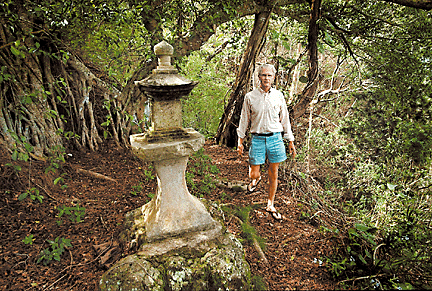



By Ken Sakamoto, Star-Bulletin
Jack Gillmar leads the way along the Dudley Talbott Trail.
The Dudley Talbott Trail is fun for young and old. If you are a serious hiker somewhere in the middle, you might find it pretty tame. But you can always find somebody at either end of the scale who will be delighted to accompany you on an easy walk to see one of the greatest views of Windward Oahu. Kaneohe’s garden
with a viewThe trail, built by Ted Talbott in honor of his grandfather, Paul Dudley, loops for about half a mile through lower Kokokahi Valley off Kaneohe Bay Drive. Jack Gillmar, president of the Friendship Garden Foundation, led a small tour of the trail and garden recently, accompanied by his wife Janet, a landscape architect who supervises maintenance of the garden, and Talbott.
The Gillmars met at Harvard and spent three years in the Peace Corps before settling in Honolulu. He is on the faculty of Hawaii School for Girls. Talbott, a CPA, grew up in rural Oregon and is an experienced trail builder. "Well, at least I am now," he said.
The garden is now an independent entity, but was established by Dr. Theodore Richards in 1927 as part of Camp Kokokahi. The camp is now across Kaneohe Bay Drive, on the bay, managed by the YWCA.
"Theodore Richards was a minister and a member of the Hawaiian Board of Missions," Gillmar said. "He wanted to start a church camp where kids of different ethnic backgrounds could learn to know each other. He started with a little camp on Coconut Island."
But a few years later, Fleishman Yeast heir Chris Holmes offered to buy the Bishop Estate lease from the camp and to take over the island as a private residence.
"With the money from selling the lease, Richards bought the little valley across from the island from the Castle Estate. There was no road, but the valley was its own ecosystem, with mountains for hiking and the bay for swimming and the land between for the camp itself. He named it Kokokahi, which in Hawaiian means of one blood," Gillmar said.
Richards carried his concept even further in the 1930s, when he established a multi-racial community by setting out houselots for weekend cabins in the lower valley. He set up a racial quota based on the island's general ethnic makeup, and raffled off the lots accordingly.
"Many of them were never built on, first because of the Depression and then the start of World War II," Gillmar said. "When the war ended and the road over the Pali was improved, Kaneohe became a bedroom community for Honolulu, and most of the original owners sold their leases."
Gillmar's grandfather, Frank Scudder, was a missionary working at the camp. "My grandfather loved the garden, and he brought us here frequently to visit. The garden was laid out by Richard Tongg, a Honolulu landscape architect who was famous for his multi-cultural plans."
But as years passed, and the camp on the bay front grew through grants from the Richards and Atherton trusts, the garden on the mauka side of the highway above the houselots was forgotten. It was Gillmar and a few others who were motivated to restore it. They founded the Friendship Garden Foundation and have a 50-year lease on the property.
"We have tried to keep to Tongg's original plans," Janet Gillmar said. "He put in monkeypods, a bamboo grove and lots of lauae fern." A planting of Washingtonia palms grows at the entrance to the Friendship Garden, a fan palm much like the pritchardia.
The loop trail starts from a low flight of stairs beside the palms. "The steps are recycled curbstones we got in the mid 1970s when the city widened King Street between Punahou and McCully," Janet Gillmar explained. "The steps give the garden a sense of entrance."
The lower part of the loop trail crosses a small bridge below a teahouse, and has a lookout at the edge of a waterfall. From the lookout is a spectacular view of Kaneohe Bay to Laie and of the Koolau Mountains. The upper part of the trail, built single-handedly by Ted Talbott, goes through groves of banyans and Norfolk Island pines. From the ridge lookout, you can see from Makapuu to Molokai.
"All of this was originally planted in the 1920s and '30s, and we have tried to keep it as a time warp. When you are up here, you can't hear anything but the birds and the movement of the bamboo. You forget entirely that you are just above a neighborhood subdivision," Gillmar said.
Free access to the Friendship Garden and the loop trail is during daylight hours, from the end of Kokokahi Place, which is opposite Kokohahi YWCA on Kaneohe Bay Drive. Parking is very limited. The "hike" is really a hilly walk in beautiful surroundings with glorious views.
Gardening Calendar in Do It Electric!
Send queries along with name and phone number to:
Evergreen by Lois Taylor, Honolulu Star-Bulletin, P.O. Box 3080, Honolulu 96802.
Or send e-mail to features@starbulletin.com.
Please be sure to include a phone number.
Evergreen by Lois Taylor is a regular Friday feature of the
Honolulu Star-Bulletin. © 1998 All rights reserved.